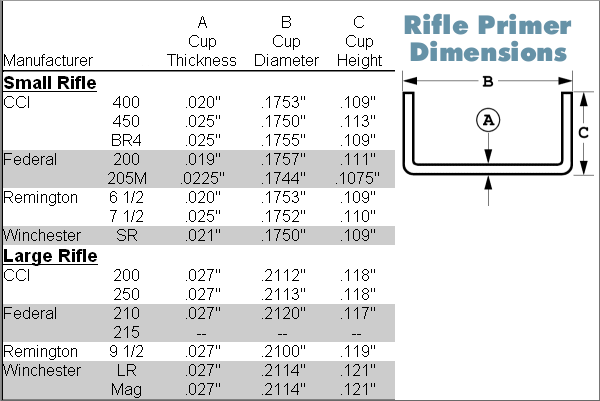Primers and Pressure Analysis by James Calhoon
by James Calhoon
(First Printed in Varmint Hunter Magazine, October, 1995)

In the course of talking to many shooters, it has become clear to me that the manufacturers of primers have done a less than adequate job of educating reloaders on the application of their primers. Everybody seems to realize that some primers are “hotter” than others and some seem to shoot better for them than others, but few reloaders know that primers have different pressure tolerances.

Primer Pressure Tolerance
When loading a .223 to the maximum, I was getting primer piercing before I reached case overloading. I don’t know what prompted me to try CCI 450s instead of the 400s which I had been using, but I did. Presto! No more piercing! Interesting!? A primer that has a hotter ignition and yet withstands more pressure! Thats when I decided that it was time to do a dissection of all primers concerned. The chart below shows my results.

By studying the numbers (Cup “A” thickness), one can see which primers in the small rifle sections should be more resistant to primer cratering and/or piercing. Primer cup diameters are all similar and appear to follow a specification, but check out the cup thickness in the small rifle primers (Dimension “A”). Some cups are quite a bit thicker than others: .025″ for CCI 450 vs. .0019″ for Fed 200. Large rifle primers all appear to have the same cup thickness, no matter what the type. (As a note of interest, small pistol primers are .017″ thick and large pistol primers are .020″ thick.)
If you are shooting a 22 Cooper, Hornet, or a Bee, the .020″ cup will perform admirably. But try using the .020″ cup in a 17 Remington and you will pierce primers, even with moderate loads.
Considering that cup thickness varies in the small rifle primers, it is obvious that primer “flatness” cannot solely be used as a pressure indicator.
Another factor which determines the strength of a primer cup is the work-hardened state of the metal used to make the primer cup. Most primers are made with cartridge brass (70% copper, 30% zinc), which can vary from 46,000 psi, soft, to 76,000 psi tensile strength when fully hardened. Note that manufacturers specify the hardness of metal desired, so some cups are definitely “harder” that others.
What does all this mean to the reloader?
- Cases that utilize small rifle primers and operate at moderate pressures (40,000 psi) can use CCI 400, Federal 200, Rem 6 1/2, or Win SR. Such cases include 22 CCM, 22 Hornet and the 218 Bee. Other cases that use the small rifle primer can use the above primers only if moderate loads are used. Keep to the lower end of reloading recommendations.– Cases that utilize small rifle primers and operate at higher pressures (55,000 psi) should use CCI 450, CCI BR4, Fed 205 and Rem 7 1/2.
– All the large rifle primers measured have the same thickness. Therefore choose based on other factors, such as accuracy, low ES/SD, cost, cup hardness, and uniformity.
Hope this clears up some primer confusion. If you want more information about primers, priming compounds, or even how to make primers, the NRA sells an excellent book called “Ammunition Making” by George Frost. This book tells it like it is in the ammo making industry.



















Great article. I am curious what the CCI BR2 Large primer cup thickness would measure?
Great info, this guy used to shoot buckets of bullets at gophers all day long out at my dads farm in Airdrie Alberta Canada!
Nice article. But in AR15s using CCI 400 primers, the primer always gets dumped before it pierces.
The book mentioned, “Ammunition Making”, by George Frost is extraordinary reading.
I think that a more important specification would be the primer cup, material hardness! A thinner hard cup would potentially deform less than a thicker soft one… What is required is that with a given firing pin spring, the pin strikes with enough force to cause enough penetration that the cup strikes the anvil and causes the primer to fire. I would suggest the cup be as soft as possible without piercing or flattening for the given load. As always trial and error dictates which primer you use.
Great Article!
Any Wolf primer info?
Yeah, nice article but a little dated. Production specs on some products may have changed since 1995.
Many primers will show cratering before significant pressure is noted if the firing pin hole in the bolt is too large. Bushing the bolt is the cure for this but is difficult or impossible to achieve in gas guns generally.
I’ll try to measure cup thickness of some Wolf/Tula KVB-223 and KVB-223M spent primers later today just to add some current info. The M denotes a magnum cup with the came level of charge as the 223 primer BTW. Wolf/Tula’s 556 primer is a true small rifle magnum primer.
Good article, matches my experience (albeit dated).
Unfortunately the reference book you recommend is no longer available “Ammunition Making” by George Frost. I searched on Palladium Press, the NRA store and a general search and found no source to purchase it.
Cool James used to shoot gophers at my Dads farm in Alberta near Calgary. He used to bring out his 22-250 and two ice cream pails full of bullets to shoot off in an afternoon.
I certainly found this article to be beneficial when I first read it and still good knowledge to have. I have one question though. In the small rifle portion he shows Fed 200. Might this be a typo? Far back as I’ve been able to trace the Fed 200 was and is a small pistol mag primer.